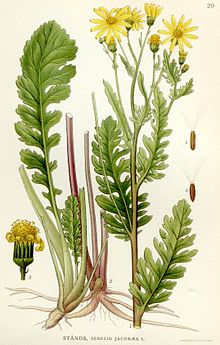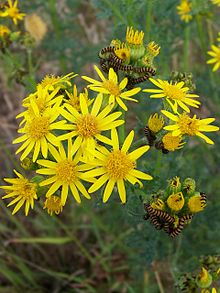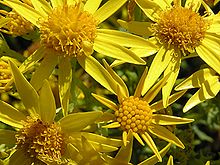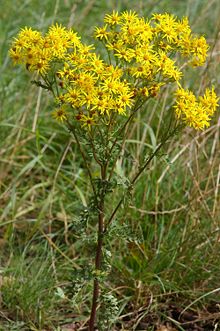- Jacobaea vulgaris
-
Jacobaea vulgaris 
Scientific classification Kingdom: Plantae (unranked): Angiosperms (unranked): Eudicots (unranked): Asterids Order: Asterales Family: Asteraceae Subfamily: Asteroideae Tribe: Senecioneae Genus: Jacobaea Species: J. vulgaris Binomial name Jacobaea vulgaris
Gaertn. (1754)Synonyms Ragwort (Jacobaea vulgaris, syn. Senecio jacobaea) is a very common wild flower in the family Asteraceae that is native to northern Eurasia, usually in dry, open places, and has also been widely distributed as a weed elsewhere.
Alternative names include Cushag (Isle of Man), Buachalán Buí (Ireland) or Benweed, Tansy Ragwort, St. James-wort, Ragweed, Stinking Nanny/Ninny/Willy, Staggerwort, Dog Standard, Cankerwort, Stammerwort and Mare's Fart. In the western US it is generally known as "Tansy Ragwort", or even more confusingly "Tansy", though its resemblance to the true tansy is superficial at best. This is a potentially dangerous misuse of names, since the true tansy has been used for culinary purposes.
Contents
Botanical description
The plant is biennial or perennial. The stems are erect, straight, have no or few hairs, and reach a height of 0.3-2.0 metres. The leaves are pinnately lobed and the end lobe is blunt. The many names that include the word "stinking" (and Mare's Fart) arise because of the unpleasant smell of the leaves. The hermaphrodite flower heads are 1.5-2.5 cm diameter, and are borne in dense, flat-topped clusters; the florets are bright yellow. It has a long flowering period lasting from June to November (In the northern Hemisphere).
Pollination is by a wide range of bees, flies and moths and butterflies. Over a season, one plant may produce 2,000 to 2,500 yellow flowers in 20- to 60-headed, flat-topped corymbs. This number of seeds produced may be as large as 75,000 to 120,000, although in its native range in Eurasia very few of these would grow into new plants and research has shown that most seeds do not travel a great distance from the parent plant.[4][5]
Taxonomy
Two subspecies are accepted:
- Jacobaea vulgaris ssp. vulgaris - the typical plant, with ray florets present.
- Jacobaea vulgaris ssp. dunensis - the ray florets are missing.
Distribution
Ragwort can be found along road sides and waste grounds, and grows in all cool and high rainfall areas.
The Ragwort is native to the Eurasian continent. In Europe it is widely spread, from Scandinavia to the Mediterranean. In Britain and Ireland it is listed as a weed. In the USA it has been introduced, and is present mainly in the North West and North East: California, Idaho, Illinois, Maine, Massachusetts, Michigan, Montana, New Jersey, New York, Oregon, Pennsylvania, and Washington.
In South America it grows in Argentina, in Africa in the north, and on the Asian continent in India and Siberia. It is widespread weed in New Zealand and Australia. In many Australian states ragwort has been declared a noxious weed. This status requires landholders to remove it from their property, by law. The same applies to New Zealand where farmers sometimes bring in helicopters to spray their farms if the ragwort is too widespread.
Biological control
Ragwort is foodplant for the larvae of Cochylis atricapitana, Phycitodes maritima, and Phycitodes saxicolais. Ragwort is best known as the food of caterpillars of the Cinnabar moth Tyria jacobaeae. They absorb alkaloids from the plant and become distasteful to predators, a fact advertised by the black and yellow warning colours. The red and black, day-flying adult moth is also distasteful to many potential predators. The moth is used as a control for ragwort in countries in which it has been introduced and become a problem, like New Zealand and the western United States. In both countries, the ragwort flea beetle (Longitarsus jacobaeae) has been introduced to combat the plant.
In the UK, where the plant is native, at least 30 species of invertebrate, many of them rare or declining, are entirely dependent on ragwort as a food source and hundreds of species will feed on its nectar, making it a vitally important component of the native flora.
Ragwort is hostplant for Longitarsus ganglbaueri.
Poisonous effects
Ragwort contains many different alkaloids, making it poisonous to animals. (EHC 80,section 9.1.4). Alkaloids which have been found in the plant confirmed by the WHO report EHC 80 are -- jacobine, jaconine, jacozine, otosenine, retrorsine, seneciphylline, senecionine, and senkirkine (pp322 Appendix II). Other alkaloids claimed to be present but from an undeclared source are acetylerucifoline, (Z)-erucifoline, (E)-erucifoline, 21-hydroxyintegerrimine, integerrimine, jacoline, riddelline, senecivernine, spartioidine, and usaramine.
Ragwort is of concern to people who keep horses and cattle. In areas of the world where ragwort is a native plant, such as Britain and continental Europe, documented cases of proven poisoning are rare. Horses do not normally eat fresh ragwort due to its bitter taste. It loses this taste when dried and can become a danger in hay. The result, if sufficient quantity is consumed, can be irreversible cirrhosis of the liver. Signs that a horse has been poisoned include yellow mucus membranes, depression, and lack of coordination. Animals may also resort to the consumption of ragwort when there is shortage of food. In rare cases they can even become addicted to it. Sheep, in marked contrast, eat small quantities of the plant with relish. Sheep and goats suffer the same process of liver destruction but at a reduced rate to horses and pigs. They seem to profit slightly from eating it; according to some reports[who?], the alkaloids kill worms in the sheep's stomach.
The danger of Ragwort is that the toxin can have a cumulative effect. The alkaloid does not actually accumulate in the liver but a breakdown product can damage DNA and progressively kills cells. About 3-7% of the body weight is sometimes claimed as deadly for horses, but an example in the scientific literature exists of a horse surviving being fed over 20% of its body weight. The effect of low doses is lessened by the destruction of the original alkaloids by the action of bacteria in the digestive tract before they reach the bloodstream. There is no known antidote or cure to poisoning, but examples are known from the scientific literature of horses making a full recovery once consumption has been stopped.[6][7]
Ragwort poses little risk to the livers of humans since, although it is theoretically poisonous to humans, it is distasteful and is not used as a food. The alkaloids can be absorbed in small quantities through the skin but studies have shown that the absorption is very much less than by ingestion. Also they are in the N-oxide form which only becomes toxic after conversion inside the digestive tract and they will be excreted harmlessly.
Some sensitive individuals can suffer from an allergic reaction because ragwort like many members of the compositae family contains sesquiterpine lactones which can cause compositae dermatitis. These are different from the pyrrolizidine alkaloids which are responsible for the toxic effects.
Honey collected over Ragwort has been found to contain small quantities of jacoline, jacobine, jacozine, senecionine, and seneciphylline, but the quantities have been judged as too minute to be of concern.[8]
Control legislation
Republic of Ireland
In the Republic of Ireland, The Noxious Weeds (Thistle, Ragwort, and Dock) Order 1937, issued under The Noxious Weeds Act 1936, declares ragwort as a noxious weed, requiring landowners to control its growth.[9]
United Kingdom
In the United Kingdom, Common Ragwort (Senecio jacobaea) is one of the five plants named as an injurious weed under the provisions of the Weeds Act 1959. The word injurious in this context indicates that it could be harmful to agriculture not that it is dangerous to animals, as all the other injurious weeds listed are non-toxic. Under the terms of this act, a land occupier can be required by the Secretary of State for Environment, Food and Rural Affairs to prevent the spread of the plant. However, the growth of the plant is not made illegal by the act and there is no statutory obligation for control placed upon landowners in general.[10]
A private member's bill, the Ragwort Control Bill, was introduced by John Greenway and was passed by the House of Commons in 2003. The act provides for a code of practice on ragwort but does not place any further legal responsibilities on landowners to control the plant.[11]
Medicine
From medieval times to the mid 20th century, Ragwort was used against inflammations of the eye, for sore and cancerous ulcers, rheumatism, sciatica and gout, for painful joints.
According to some, it would relieve the pain of bee stings.
Any applications are external only, never taken internally, and only under professional supervision.
With the large range of pyrrolizidine alkaloids, which are known to inhibit or reduce cell division, some researchers hope to use them to slow down or arrest the growth of cells in cancer.[who?]
Other usage
In ancient Greece and Rome a supposed aphrodisiac was made from the plant; it was called satyrion.
Also, the leaves can be used to obtain good green dye, as yellow dye is obtained from the flowers, as can be done for brown and orange.
Literature, poetry and mythology
The Greek physician Dioscorides (c.40-90 CE) recommended the herb. The two "fathers" of herbalism, Gerard and Culpeper, also recommended the herb.
The poet John Clare had a more positive opinion of the plant, as revealed in this poem of 1831:
- Ragwort thou humble flower with tattered leaves
- I love to see thee come & litter gold...
- Thy waste of shining blossoms richly shields
- The sun tanned sward in splendid hues that burn
- So bright & glaring that the very light
- Of the rich sunshine doth to paleness turn
- & seems but very shadows in thy sight.
Josephine Kermode (1852–1937) wrote the following poem about the Cushag.
"The Cushag"
- Now, the Cushag, we know,
- Must never grow,
- Where the farmer's work is done.
- But along the rills,
- In the heart of the hills,
- The Cushag may shine like the sun.
- Where the golden flowers,
- Have fairy powers,
- To gladden our hearts with their grace.
- And in Vannin Veg Veen,
- In the valleys green,
- The Cushags have still a place.
(Vannin Veg Veen is Manx for dear little Isle of Man)
Donald Macalastair of Druim-a-ghinnir on the Isle of Arran told a story of the fairies journeying to Ireland. The ragwort was their transport and every one of them picked a plant, sat astride and arrived in Ireland in an instant.[12]
Cultivation
Ragwort is not cultivated. There are no varieties known.
See also
References
- ^ Germplasm Resources Information Network (GRIN) (1996-09-17). "Genus: Othonna L.". Taxonomy for Plants. USDA, ARS, National Genetic Resources Program, National Germplasm Resources Laboratory, Beltsville, Maryland. http://www.ars-grin.gov/cgi-bin/npgs/html/genus.pl?8654. Retrieved 2008-05-22.
- ^ UniProt. "Species Senecio jacobaea" (HTML). http://beta.uniprot.org/taxonomy/98722. Retrieved 2008-06-29.
- ^ International Organization for Plant Information (IOPI). "Plant Name Search Results" (HTML). International Plant Names Index. http://www.ipni.org/ipni/idPlantNameSearch.do?id=226649-1. Retrieved 2008-06-29.
- ^ Poole, A. and D. Cairns. 1940. Botanical aspects of ragwort (Senecio jacobaea L.) control. Bulletin of the New Zealand Department of Science and Industrial Research 82: 1-66.
- ^ McEvoy P.B. and Cox C. S. Wind Dispersal Distances in Dimorphic Achenes of Ragwort, Senecio Jacobaea Ecology 68(6) 1987 pp 206-2015
- ^ De Lanux-Van Gorder, V. 2000. Tansy ragwort poisoning in a horse in southern Ontario. Can. Vet. J. 41: 09-410.
- ^ Lessard, P., W. D. Wilson, H. J. Olander, Q. R. Rogers, & V. E. Mendel. 1986. Clinicopathologic study of horses surviving pyrrolizidine alkaloid (Senecio vulgaris) toxicosis. Am. J. Vet. Res. 47: 1776-1780.
- ^ Ministry of Agriculture, Fisheries and Food (1995), Surveillance for pyrrolizidine alkaloids in honey, UK Food Standards Agency, http://archive.food.gov.uk/maff/archive/food/infsheet/1995/no52/52honey.htm, retrieved 2007-08-12
- ^ Ragwort in Ireland
- ^ Department for Environment, Food and Rural Affairs, Weeds Act 1959, Department for Environment, Food and Rural Affairs, http://www.defra.gov.uk/rds/weeds-act.htm, retrieved 2007-08-12
- ^ Office of Public Sector Information, Ragwort Control Act 2003, http://www.opsi.gov.uk/acts/acts2003/20030040.htm, retrieved 2007-08-12
- ^ Wentz, W. Y. (1911). The Fairy-faith in Celtic Countries. Reprinted. Colin Smythe (1981). ISBN 0-901072-51-8. P. 87.
External links
- Plume moth working to control ragwort in NZ
- Environmental Health Criteria 80 Pyrrolizidine Alkaloids World Health Organisation—the full text of the report is available.
- Ragwort myths and facts This website is the English version of a Dutch Ragwort website
- Ragwort Facts.com Information on Ragwort in the UK from a scientific perspective
- Buglife's ragwort pages Information on the importance of Ragwort to wildlife on the Buglife website
- The Merck Veterinary Manual introduction to pyrrolizidine alkaloidosis
- Pieter B., Pelser; Barbara Gravendeel and Ruud van der Meijden (2002), "Tackling speciose genera: species composition and phylogenetic position of Senecio sect. Jacobaea (Asteraceae) based on plastid and nrDNA sequences", American Journal of Botany 89 (6): 929–939, doi:10.3732/ajb.89.6.929, http://www.amjbot.org/cgi/content/full/89/6/929.
Categories:- Jacobaea
- Flowers
- Plants and pollinators
Wikimedia Foundation. 2010.




